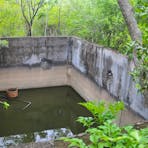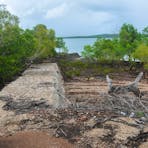Channel Island was declared a Quarantine Station by the Chief Secretary in August 1884 when all vessels had to be cleared before anchoring at Port Darwin.
It was used for a leprosy patient in 1885 and for small-pox patients from 1887. Permanent structures were not erected until September 1914 when Channel Island was one of four 'first-aid' or minor stations for all cases of disease requiring isolation. In 1930 a new Quarantine Station was opened on East Arm and Channel Island was converted to a Leprosarium. The Leprosarium is culturally significant because it provides a unique view of a compulsorily isolated group of people who existed under extreme physical and, in some cases, mental conditions. It demonstrates an official policy of enforced segregation of diseased people. The ruins are evidence of the Quarantine requirements of the period, including segregation, at a time when the rest of the world was modifying its compulsory isolation laws. The Channel Island Reef is significant for its diverse coral.
Activities
- Birdwatching
- Hiking




/f/286255898790625/eb73ce1477/keep-in-touch.jpg)